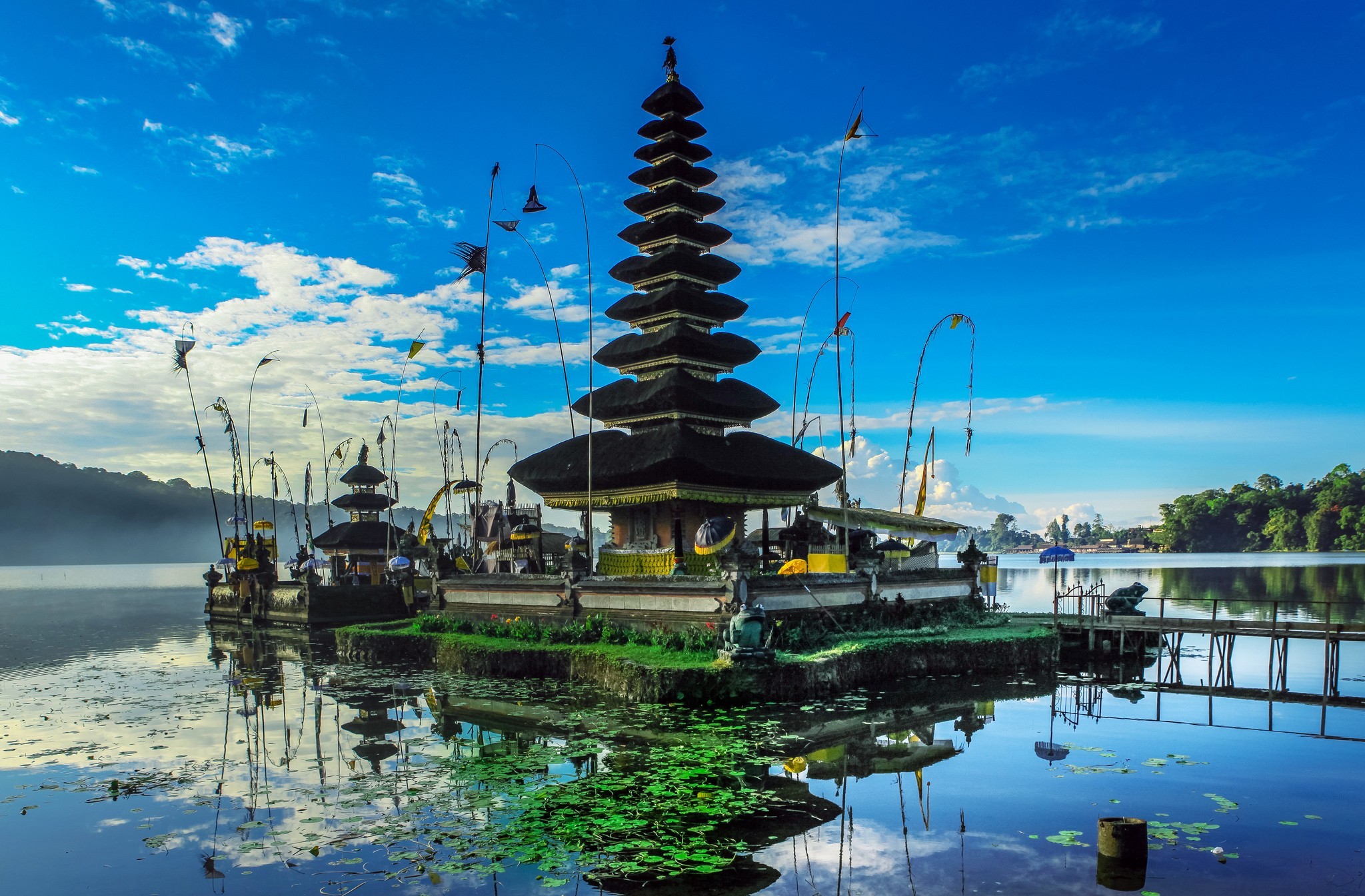Welcome to Bali, a captivating island paradise where stunning landscapes, rich culture, and endless adventure await. Nestled in the heart of Indonesia, Bali beckons travelers with its breathtaking vistas of emerald rice terraces, pristine beaches kissed by turquoise waters, and majestic volcanic peaks cloaked in mist. But beyond its picturesque scenery lies a world of cultural richness, where ancient traditions blend seamlessly with modern life. From the intricate temple ceremonies that punctuate the Balinese calendar to the tantalizing flavors of its cuisine, every corner of Bali tells a story of resilience, spirituality, and boundless beauty. Join us on a journey to uncover the hidden treasures of Bali, where each moment promises an unforgettable experience amidst the serenity of nature and the warmth of Balinese hospitality. Welcome to paradise.
Bali Overview
Location:
Bali, nestled in the Indonesian archipelago, is situated between the islands of Java and Lombok, with the Bali Strait separating it from Java to the west. Its geographic coordinates are approximately 8.3405° S latitude and 115.0920° E longitude. Bali’s accessibility via Ngurah Rai International Airport, located near the capital city of Denpasar, facilitates seamless travel connections for visitors arriving by air. Additionally, Bali’s strategic location within the Coral Triangle makes it a hotspot for marine biodiversity, offering unparalleled diving and snorkeling experiences.
Significance:
Bali holds profound significance as the last remaining Hindu-majority province in Indonesia, with Hinduism deeply woven into the fabric of everyday life. The island’s cultural heritage is reflected in its ancient temples, such as the iconic Tanah Lot and Uluwatu temples, which stand as testament to Bali’s spiritual legacy. Furthermore, Bali’s artistic traditions, including dance, music, and crafts, continue to thrive, enriching the island’s cultural landscape and attracting admirers from around the world. The Balinese calendar is punctuated by colorful festivals and ceremonies, such as Galungan and Nyepi, offering visitors a glimpse into the island’s spiritual and cultural heritage.
Reputation as a Tourist Destination:
Bali’s reputation as a premier tourist destination stems from its unparalleled natural beauty, diverse attractions, and warm hospitality. The island’s rugged coastlines, verdant rice terraces, and towering volcanic peaks create a stunning backdrop for travelers seeking adventure, relaxation, or cultural immersion. Bali’s beaches, including Kuta, Seminyak, and Nusa Dua, are renowned for their golden sands and world-class surfing conditions, while inland areas like Ubud offer tranquil retreats amidst lush jungles and terraced landscapes. Furthermore, Bali’s reputation as a food lover’s paradise is well-deserved, with a myriad of dining options ranging from traditional warungs serving local delicacies to upscale restaurants showcasing international cuisine. Whether exploring ancient temples, embarking on outdoor adventures, or simply soaking in the island’s natural beauty, Bali offers a wealth of experiences to suit every traveler’s preferences, earning its status as a must-visit destination on the global tourism map.
Geo- Cultural Insights about Bali:
Geographic Details:
Volcanic Legacy: Bali’s landscape is shaped by its volcanic origins, with Mount Agung standing as the island’s highest peak at 3,031 meters (9,944 feet) above sea level. This active volcano not only contributes to the island’s fertility but also holds spiritual significance for the Balinese people, who consider it the abode of the gods.
ubak Irrigation System: One of Bali’s most remarkable features is its intricate subak irrigation system, recognized as a UNESCO World Heritage Site. Dating back over a thousand years, this traditional water management system sustains the island’s iconic rice terraces, ensuring a steady supply of water for agricultural purposes while preserving the island’s scenic beauty.
Breathtaking Beaches: Bali boasts an extensive coastline dotted with pristine beaches, each offering its own unique charm and activities. From the bustling shores of Kuta and Seminyak to the secluded coves of Nusa Dua and Padang Padang, Bali’s beaches cater to sunbathers, surfers, snorkelers, and beachcombers alike, making it a paradise for coastal enthusiasts.
Coral Reef Diversity: Beneath the crystal-clear waters surrounding Bali lies a vibrant marine ecosystem teeming with life. The island’s coral reefs are home to an astonishing array of marine species, including colorful fish, sea turtles, and even the elusive manta rays. Snorkeling and diving enthusiasts flock to sites like Menjangan Island and the USS Liberty wreck to explore these underwater wonders.
Cultural Richness:
Hindu Temples: Bali is renowned for its countless Hindu temples, known locally as puras, which serve as focal points for worship, community gatherings, and cultural celebrations. Among the most revered temples are Besakih, Bali’s largest and holiest temple complex, and Pura Ulun Danu Bratan, a picturesque water temple set against the backdrop of Lake Bratan.
Traditional Architecture: Balinese architecture is characterized by its harmonious blend of Hindu symbolism, intricate carvings, and traditional building techniques. The island’s temples, palaces, and pavilions showcase ornate detailing, with towering meru towers symbolizing the sacred Mount Meru, the center of the universe in Hindu cosmology.
Colorful Festivals: Bali’s calendar is filled with vibrant festivals and cultural celebrations that showcase the island’s rich heritage. Among the most notable is Galungan, a Hindu festival commemorating the victory of dharma (good) over adharma (evil), marked by elaborate offerings, traditional dances, and processions throughout the island. Another highlight is Nyepi, or the Day of Silence, when the entire island comes to a standstill as Balinese Hindus observe a day of introspection, meditation, and fasting.
Symbolism and Tradition: Balinese culture is steeped in symbolism and tradition, with rituals and ceremonies playing a central role in daily life. From the elaborate cremation ceremonies known as Ngaben to the rhythmic kecak dances performed against the backdrop of fiery sunsets, Bali’s cultural heritage is alive and thriving, offering visitors a glimpse into a world where spirituality and artistry intertwine.
Exploring the Must-Visit Tourist Destinations in Bali Island
1. Ubud: Cultural Heart of Bali

Ubud is renowned for its lush rice terraces, vibrant arts scene, and spiritual atmosphere. Nestled amidst the island’s central highlands, it offers a tranquil retreat from the hustle and bustle of Bali’s coastal areas.
How to Get There from the Capital (Jakarta):
- By Air: Fly from Jakarta to Ngurah Rai International Airport in Denpasar, Bali. From there, take a taxi or shuttle bus to Ubud, approximately 1.5 to 2 hours away.
- By Road: Take a bus or drive from Jakarta to Gilimanuk Port in West Bali. Then, board a ferry to Ketapang Port in East Java. From there, it’s a scenic drive through lush countryside to Ubud.
- By Sea: If coming from Java, you can take a ferry from Banyuwangi to Gilimanuk, then continue by road to Ubud.
Other Transportation:
- Private: Hire a private car with a driver for convenience and flexibility. Prices vary depending on the duration of the rental and the type of vehicle.
- Motorbike Rental: Explore Ubud and its surrounding areas on a rented motorbike, offering freedom and affordability for budget travelers.
Transportation Cost:
- Public: Bus fares from Denpasar to Ubud range from IDR 50,000 to IDR 80,000 ($3.50 to $5.50 USD) per person. Shuttle buses may cost slightly more.
- Private: Hiring a private car with a driver for a day trip to Ubud typically costs between IDR 500,000 to IDR 800,000 ($35 to $55 USD), depending on the duration and itinerary.
Must-Do Activities:
- Visit Ubud Monkey Forest to interact with playful macaques and explore ancient temples.
- Wander through the Tegalalang Rice Terraces for breathtaking views and photo opportunities.
- Experience traditional Balinese dance performances at Ubud Palace or local art studios.
- Join a yoga class or wellness retreat to rejuvenate mind, body, and spirit.
- Explore Ubud’s vibrant markets for handcrafted souvenirs, artwork, and local cuisine.
Entrance Fee:
- Ubud Monkey Forest: IDR 80,000 ($5.50 USD) for adults, IDR 60,000 ($4.00 USD) for children.
- Tegalalang Rice Terraces: Entrance is free, but there may be small parking fees (approximately IDR 10,000 to IDR 20,000).
- Ubud Palace: Admission to the palace grounds is free, but donations are appreciated during cultural performances.
- Yoga classes and wellness activities vary in price, with drop-in sessions typically ranging from IDR 100,000 to IDR 300,000 ($7 to $21 USD) per class.
2. Kuta: Bali’s Vibrant Beach Destination
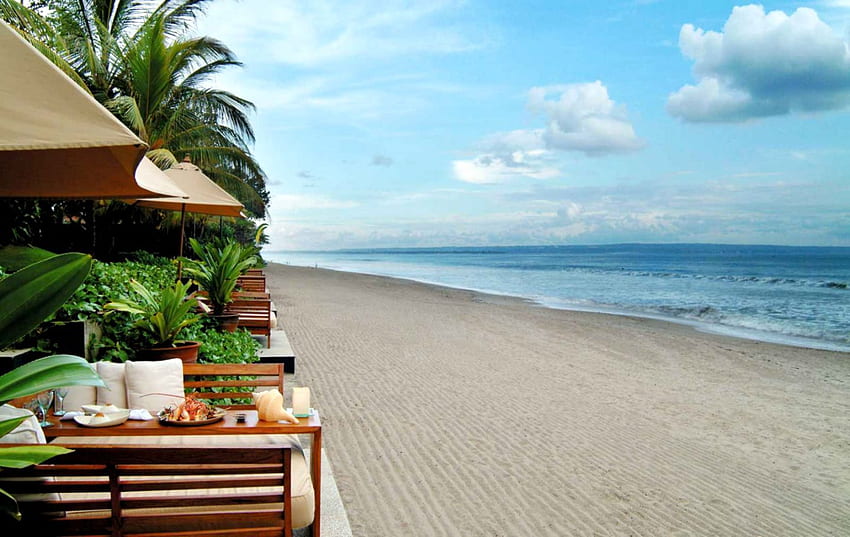
Kuta is famous for its lively atmosphere, golden sand beaches, and bustling nightlife. Located on the southwestern coast of Bali, it offers a perfect blend of sun, surf, and entertainment.
How to Get There from the Capital (Jakarta):
- By Air: Fly from Jakarta to Ngurah Rai International Airport in Denpasar, Bali. From there, take a taxi or shuttle bus to Kuta, approximately 15 to 20 minutes away.
- By Road: Take a bus or drive from Jakarta to Denpasar. From Denpasar, continue by taxi or public bus to Kuta.
- By Sea: There are no direct sea routes from Jakarta to Kuta. Travelers can opt for a combination of sea and road travel via ferry from Java to Bali, followed by a taxi or shuttle bus to Kuta.
Other Transportation:
- Private: Hire a private car or taxi for convenience and privacy, with rates varying based on distance and time of travel.
- Motorbike Rental: Renting a scooter or motorbike is a popular option for exploring Kuta and its surrounding areas, offering flexibility and affordability.
Transportation Cost:
- Public: Public buses or shuttle services from Denpasar to Kuta typically cost around IDR 20,000 to IDR 50,000 ($1.50 to $3.50 USD) per person.
- Private: Taxi fares from Ngurah Rai International Airport to Kuta range from IDR 70,000 to IDR 100,000 ($5 to $7 USD), depending on traffic and distance.
Must-Do Activities:
- Soak up the sun on Kuta Beach and enjoy swimming, surfing, or beach volleyball.
- Experience vibrant nightlife at bars, clubs, and beachfront cafes along Jalan Pantai Kuta.
- Shop for souvenirs, clothing, and handicrafts at Kuta Art Market and Beachwalk Shopping Center.
- Enjoy water sports such as parasailing, jet skiing, and banana boat rides.
- Witness stunning sunsets while sipping cocktails at beachfront bars like Ku De Ta or Potato Head.
Entrance Fee:
- Kuta Beach: Free admission, but water sports activities may have separate charges.
- Kuta Art Market: No entrance fee, but prices for goods vary.
- Nightclubs and bars may have cover charges or minimum spend requirements, ranging from IDR 50,000 to IDR 200,000 ($3.50 to $14 USD) per person.
3. Seminyak: Bali’s Trendy Beach and Dining Hub
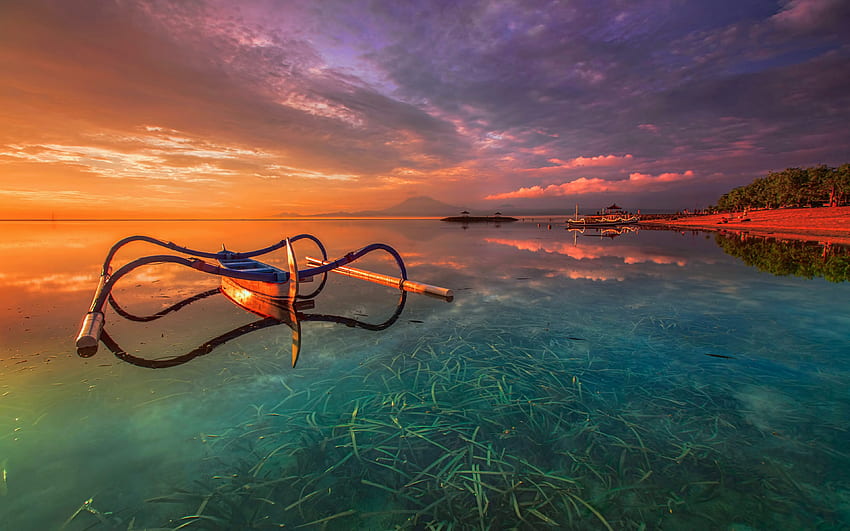
Seminyak epitomizes Bali’s upscale beach lifestyle, offering a sophisticated atmosphere, chic boutiques, and world-class dining options. Located north of Kuta, Seminyak is renowned for its luxury resorts, stylish beach clubs, and vibrant shopping scene.
How to Get There from the Capital (Jakarta):
- By Air: Fly from Jakarta to Ngurah Rai International Airport in Denpasar, Bali. From there, take a taxi or shuttle bus to Seminyak, approximately 30 to 45 minutes away.
- By Road: Travelers can take a bus or drive from Jakarta to Denpasar. From Denpasar, continue by taxi or public bus to Seminyak.
- By Sea: There are no direct sea routes from Jakarta to Seminyak. Travelers can opt for a combination of sea and road travel via ferry from Java to Bali, followed by a taxi or shuttle bus to Seminyak.
Other Transportation:
- Private: Hire a private car or taxi for convenience and comfort, with rates varying based on distance and vehicle type.
- Motorbike Rental: Renting a scooter or motorbike is a convenient way to explore Seminyak and its surrounding areas, offering flexibility and ease of travel.
Transportation Cost:
- Public: Public buses or shuttle services from Denpasar to Seminyak typically cost around IDR 30,000 to IDR 70,000 ($2 to $5 USD) per person.
- Private: Taxi fares from Ngurah Rai International Airport to Seminyak range from IDR 100,000 to IDR 200,000 ($7 to $14 USD), depending on traffic and distance.
Must-Do Activities:
- Relax on Seminyak Beach and enjoy sunbathing, swimming, or beach soccer.
- Explore Seminyak’s upscale boutiques, art galleries, and designer stores along Jalan Raya Seminyak and Jalan Petitenget.
- Indulge in fine dining at award-winning restaurants such as Metis, Sarong, or La Lucciola.
- Experience Seminyak’s vibrant nightlife at beach clubs like Ku De Ta, Potato Head, or Mrs Sippy.
- Treat yourself to a spa day at one of Seminyak’s luxury spas, offering traditional Balinese massages and holistic treatments.
Entrance Fee:
- Seminyak Beach: Free admission, but rental fees may apply for sun loungers and umbrellas.
- Art galleries and boutiques: No entrance fee, but prices for goods vary.
- Beach clubs and restaurants may have minimum spend requirements or cover charges, ranging from IDR 100,000 to IDR 500,000 ($7 to $35 USD) per person.
4. Nusa Penida: Bali’s Untouched Island Paradise
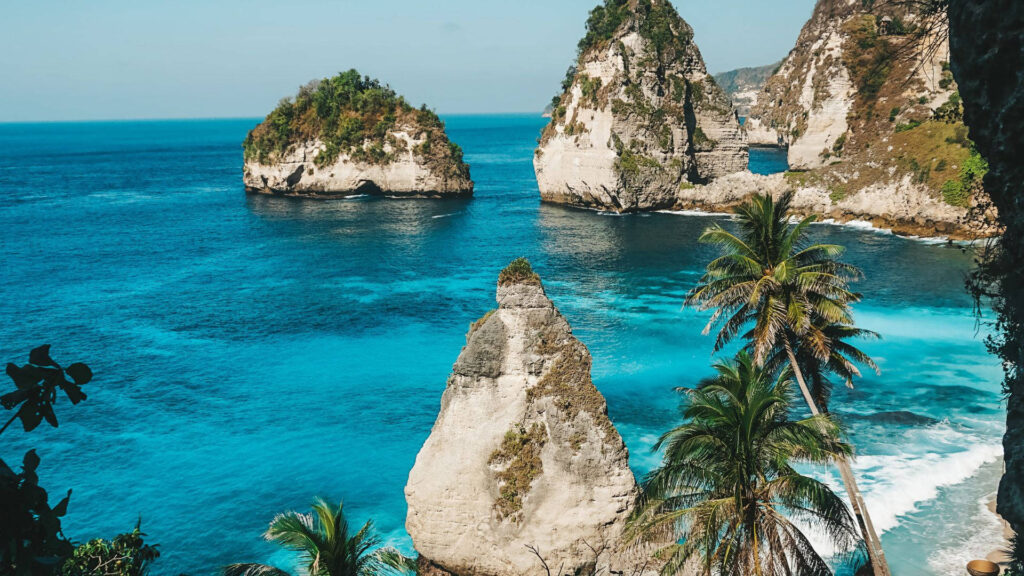
Nusa Penida is a rugged and unspoiled island located southeast of Bali, renowned for its dramatic coastal cliffs, crystal-clear waters, and pristine natural beauty. As a haven for adventurers and nature lovers, Nusa Penida offers breathtaking landscapes and unique experiences off the beaten path.
How to Get There from the Capital (Jakarta):
- By Air and Sea: Fly from Jakarta to Ngurah Rai International Airport in Denpasar, Bali. From there, take a taxi or shuttle bus to Sanur or Padangbai Harbor. Then, board a fast boat or ferry to Nusa Penida, with travel time ranging from 30 minutes to 1.5 hours.
Other Transportation:
- Private: Hire a private speedboat or charter a traditional boat for a direct transfer to Nusa Penida from Sanur or Padangbai Harbor. Prices vary depending on the number of passengers and type of vessel.
- Scooter Rental: Renting a scooter or motorbike on Nusa Penida is a popular option for exploring the island independently, offering flexibility and affordability.
Transportation Cost:
- Public: Fast boat tickets from Sanur or Padangbai to Nusa Penida typically range from IDR 150,000 to IDR 300,000 ($10 to $20 USD) per person, depending on the operator and type of vessel.
- Private: Chartering a private speedboat or traditional boat for a direct transfer to Nusa Penida can cost between IDR 1,000,000 to IDR 3,000,000 ($70 to $200 USD), depending on the size and capacity of the boat.
Must-Do Activities:
- Visit Kelingking Beach and marvel at the iconic T-Rex-shaped cliff formation overlooking turquoise waters.
- Snorkel or dive at Crystal Bay and Manta Point to encounter vibrant coral reefs, tropical fish, and majestic manta rays.
- Trek to the natural rock pool of Angel’s Billabong and swim in its crystal-clear waters while enjoying panoramic ocean views.
- Explore the rugged coastline and hidden gems of Nusa Penida, such as Broken Beach and Atuh Beach, for stunning photo opportunities and secluded relaxation.
- Hike to the cliffside temple of Pura Paluang or the sacred Goa Giri Putri Cave Temple to experience the island’s spiritual side.
Entrance Fee:
- Some attractions on Nusa Penida may require an entrance fee, typically ranging from IDR 10,000 to IDR 50,000 ($0.70 to $3.50 USD) per person. Specific fees may apply at popular sites such as Kelingking Beach or Crystal Bay.
5. Uluwatu: Bali’s Spectacular Cliffside Destination
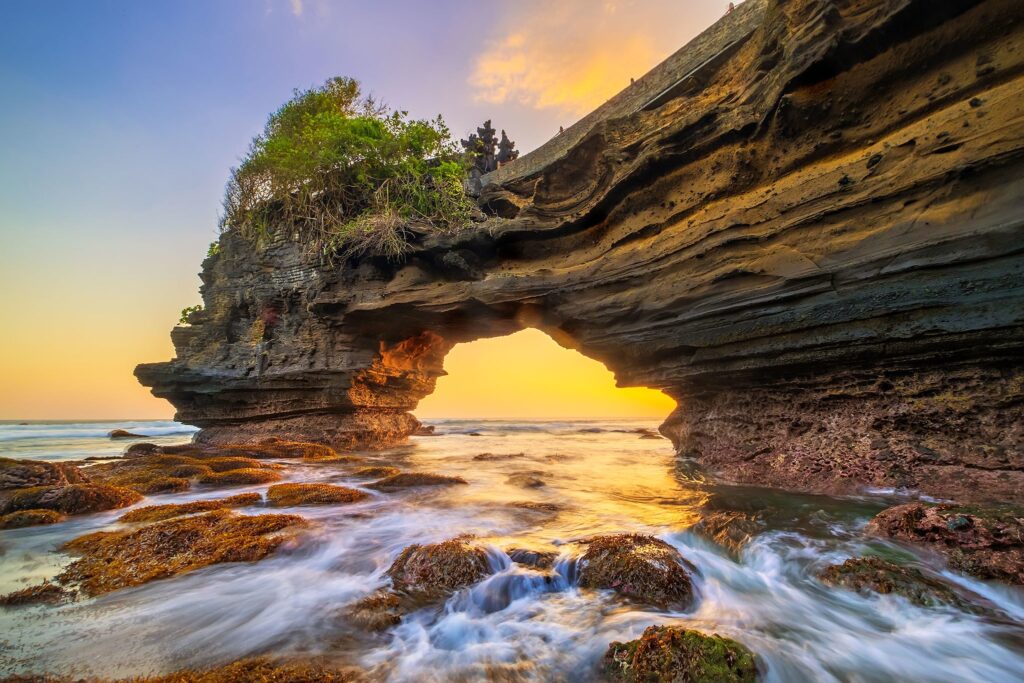
Uluwatu is a stunning coastal destination located on the southern tip of Bali, renowned for its dramatic cliffs, panoramic ocean views, and cultural attractions. Perched high above the Indian Ocean, Uluwatu offers a perfect blend of natural beauty, cultural heritage, and outdoor adventures.
How to Get There from the Capital (Jakarta):
- By Air: Fly from Jakarta to Ngurah Rai International Airport in Denpasar, Bali. From there, take a taxi or shuttle bus to Uluwatu, approximately 30 to 45 minutes away.
- By Road: Travelers can take a bus or drive from Jakarta to Denpasar. From Denpasar, continue by taxi or public bus to Uluwatu.
- By Sea: There are no direct sea routes from Jakarta to Uluwatu. Travelers can opt for a combination of sea and road travel via ferry from Java to Bali, followed by a taxi or shuttle bus to Uluwatu.
Other Transportation:
- Private: Hire a private car or taxi for convenience and flexibility, with rates varying based on distance and time of travel.
- Motorbike Rental: Renting a scooter or motorbike is a popular option for exploring Uluwatu and its surrounding areas, offering freedom and affordability for budget travelers.
Transportation Cost:
- Public: Public buses or shuttle services from Denpasar to Uluwatu typically cost around IDR 30,000 to IDR 70,000 ($2 to $5 USD) per person.
- Private: Taxi fares from Ngurah Rai International Airport to Uluwatu range from IDR 150,000 to IDR 300,000 ($10 to $20 USD), depending on traffic and distance.
Must-Do Activities:
- Visit Uluwatu Temple, a cliffside Hindu temple renowned for its stunning sunset views and traditional Kecak dance performances.
- Explore the rugged coastline and hidden beaches of Uluwatu, such as Padang Padang Beach and Thomas Beach, for surfing, sunbathing, and swimming.
- Enjoy a seafood dinner at Jimbaran Bay, where local restaurants offer fresh seafood dishes served on the beachfront.
- Watch the iconic sunset at Uluwatu’s cliffside bars and cafes, such as Single Fin and Rock Bar, while sipping cocktails and enjoying live music.
- Experience outdoor adventures like cliff jumping, snorkeling, and stand-up paddleboarding at Uluwatu’s pristine beaches and coastal areas.
Entrance Fee:
- Uluwatu Temple: Entrance fee is IDR 30,000 ($2 USD) per person for domestic visitors and IDR 50,000 ($3.50 USD) per person for international visitors. Additional fees may apply for parking or sarong rental.
Exploring Bali’s Hidden Treasures: 5 Unexplored Gems
1. Sidemen: Bali’s Hidden Gem in the Rice Terraces

Sidemen is a serene village nestled in the lush rice terraces of East Bali, offering a peaceful retreat away from the tourist crowds. This unspoiled area is renowned for its stunning landscapes, traditional Balinese culture, and authentic village life.
How to Get There from the Capital (Jakarta):
- By Air: Fly from Jakarta to Ngurah Rai International Airport in Denpasar, Bali. From there, take a taxi or shuttle bus to Sidemen, approximately 2 to 2.5 hours away.
- By Road: Travel by bus or private car from Jakarta to Denpasar. From Denpasar, continue by taxi or public bus to Sidemen.
- By Sea: While there are no direct sea routes to Sidemen, travelers can opt for a combination of sea and road travel via ferry from Java to Bali, followed by a taxi or shuttle bus to Sidemen.
Other Transportation:
- Private: Hire a private car or taxi for convenience and flexibility, with rates varying based on distance and time of travel.
- Motorbike Rental: Renting a scooter or motorbike is an excellent way to explore Sidemen and its surrounding areas, offering freedom and affordability for budget travelers.
Transportation Cost:
- Public: Public buses or shuttle services from Denpasar to Sidemen typically cost around IDR 50,000 to IDR 100,000 ($3.50 to $7 USD) per person.
- Private: Taxi fares from Ngurah Rai International Airport to Sidemen range from IDR 500,000 to IDR 800,000 ($35 to $55 USD), depending on traffic and distance.
Must to Activities:
- Trek through the scenic rice terraces and lush countryside of Sidemen, offering breathtaking views and opportunities for photography.
- Visit traditional Balinese villages and learn about local customs, crafts, and way of life.
- Join a cooking class to learn how to prepare authentic Balinese dishes using fresh ingredients from the village gardens.
- Explore hidden waterfalls and swimming spots tucked away in the jungle, offering refreshing dips and tranquil surroundings.
- Experience the serenity and spirituality of Sidemen by attending a traditional Balinese ceremony or meditation session with a local guru.
Entrance Fee:
- Entrance fees may apply for certain activities or attractions in Sidemen, such as guided trekking tours or visits to cultural sites. Prices vary depending on the activity and operator.
2. Blahmantung Waterfall: Bali’s Hidden Natural Wonder
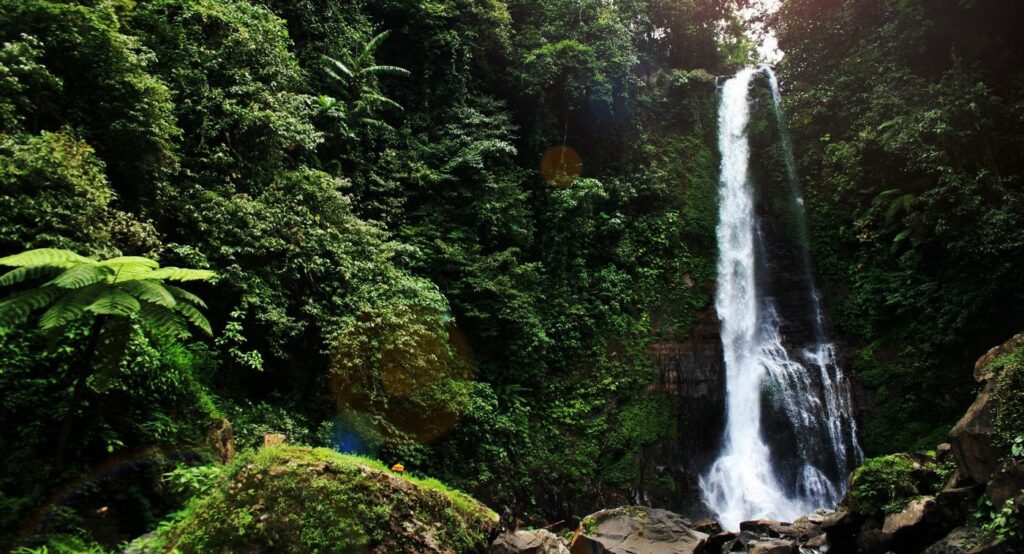
Description or Speciality:
Blahmantung Waterfall is a breathtaking hidden gem tucked away in the lush jungles of northern Bali. This secluded cascade offers a serene oasis surrounded by verdant foliage, pristine pools, and cascading waters, making it an ideal escape for nature lovers and adventure seekers.
How to Get There from the Capital (Jakarta):
- By Air: Fly from Jakarta to Ngurah Rai International Airport in Denpasar, Bali. From there, take a taxi or shuttle bus to the town of Singaraja, approximately 2.5 to 3 hours away.
- By Road: Travel by bus or private car from Jakarta to Singaraja. From Singaraja, continue by taxi or hired vehicle to Blahmantung Waterfall.
- By Sea: While there are no direct sea routes to Blahmantung Waterfall, travelers can opt for a combination of sea and road travel via ferry from Java to Bali, followed by a taxi or hired vehicle to the waterfall.
Other Transportation:
- Private: Hire a private car or taxi for convenience and flexibility, with rates varying based on distance and time of travel.
- Motorbike Rental: Renting a scooter or motorbike is an adventurous way to explore the remote areas of northern Bali, including Blahmantung Waterfall, offering freedom and affordability for budget travelers.
Transportation Cost:
- Public: Public buses or shuttle services from Denpasar to Singaraja typically cost around IDR 100,000 to IDR 150,000 ($7 to $10 USD) per person. Additional transportation may be needed from Singaraja to the waterfall.
- Private: Taxi fares from Ngurah Rai International Airport to Blahmantung Waterfall range from IDR 800,000 to IDR 1,200,000 ($55 to $80 USD), depending on distance and vehicle type.
Must to Activities:
- Trek through the jungle to reach Blahmantung Waterfall, enjoying the lush scenery and wildlife along the way.
- Swim in the refreshing pools beneath the waterfall, surrounded by pristine nature and the soothing sounds of cascading water.
- Take photos of the stunning waterfall and surrounding landscape, capturing the natural beauty of this hidden gem.
- Enjoy a picnic lunch or relaxing break in the tranquil setting of Blahmantung Waterfall, immersing yourself in the peaceful ambiance of the jungle.
- Explore nearby attractions such as traditional villages, rice terraces, and other natural wonders in northern Bali.
Entrance Fee:
- Entrance fees to Blahmantung Waterfall may apply, typically ranging from IDR 20,000 to IDR 50,000 ($1.50 to $3.50 USD) per person. Prices may vary depending on the operator and facilities available.
3. Yeh Leh Beach: Bali’s Secluded Coastal Paradise

Yeh Leh Beach is a hidden gem nestled along Bali’s rugged eastern coast, offering pristine white sands, crystal-clear waters, and a serene atmosphere away from the tourist crowds. This secluded beach is perfect for travelers seeking tranquility and natural beauty.
How to Get There from the Capital (Jakarta):
- By Air: Fly from Jakarta to Ngurah Rai International Airport in Denpasar, Bali. From there, take a taxi or shuttle bus to the town of Candidasa, approximately 2 to 2.5 hours away.
- By Road: Travel by bus or private car from Jakarta to Candidasa. From Candidasa, continue by taxi or hired vehicle to Yeh Leh Beach.
- By Sea: While there are no direct sea routes to Yeh Leh Beach, travelers can opt for a combination of sea and road travel via ferry from Java to Bali, followed by a taxi or hired vehicle to the beach.
Other Transportation:
- Private: Hire a private car or taxi for convenience and flexibility, with rates varying based on distance and time of travel.
- Motorbike Rental: Renting a scooter or motorbike is a popular way to explore the coastal areas of eastern Bali, including Yeh Leh Beach, offering freedom and affordability for budget travelers.
Transportation Cost:
- Public: Public buses or shuttle services from Denpasar to Candidasa typically cost around IDR 100,000 to IDR 150,000 ($7 to $10 USD) per person. Additional transportation may be needed from Candidasa to Yeh Leh Beach.
- Private: Taxi fares from Ngurah Rai International Airport to Yeh Leh Beach range from IDR 700,000 to IDR 1,000,000 ($50 to $70 USD), depending on distance and vehicle type.
Must to Activities:
- Relax on the tranquil shores of Yeh Leh Beach, enjoying the peaceful ambiance and stunning coastal scenery.
- Swim or snorkel in the crystal-clear waters of the bay, exploring vibrant coral reefs and marine life just offshore.
- Take a leisurely stroll along the beach, collecting seashells and admiring the natural beauty of the coastline.
- Enjoy a picnic lunch or beachside barbecue with friends and family, savoring delicious food amidst the scenic surroundings.
- Explore nearby attractions such as traditional villages, hidden coves, and scenic viewpoints along the eastern coast of Bali.
Entrance Fee:
- Yeh Leh Beach is typically free to access, with no entrance fee required for visitors. However, facilities such as parking or amenities may have associated fees.
4. Tukad Cepung Waterfall: Bali’s Enchanting Hidden Gem
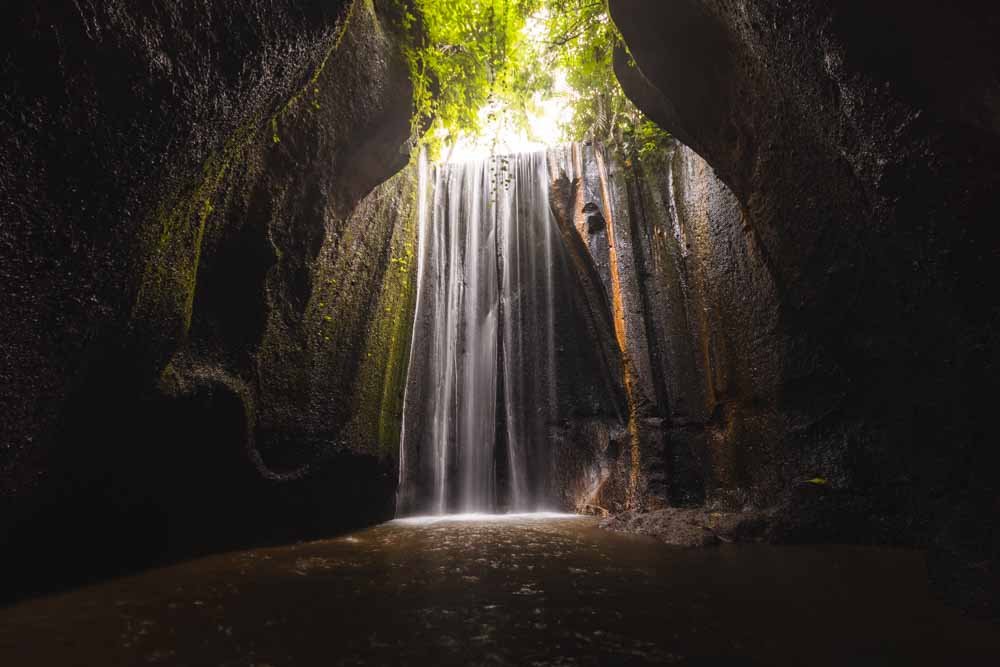
Tukad Cepung Waterfall is a magical hidden gem tucked within a lush canyon in the heart of Bali. This enchanting waterfall is unique as it cascades through a natural cave, creating a mesmerizing play of light and shadow, and offering a truly mystical experience for visitors.
How to Get There from the Capital (Jakarta):
- By Air: Fly from Jakarta to Ngurah Rai International Airport in Denpasar, Bali. From there, take a taxi or shuttle bus to the town of Bangli, approximately 1.5 to 2 hours away.
- By Road: Travel by bus or private car from Jakarta to Bangli. From Bangli, continue by taxi or hired vehicle to Tukad Cepung Waterfall.
- By Sea: While there are no direct sea routes to Tukad Cepung Waterfall, travelers can opt for a combination of sea and road travel via ferry from Java to Bali, followed by a taxi or hired vehicle to the waterfall.
Other Transportation:
- Private: Hire a private car or taxi for convenience and flexibility, with rates varying based on distance and time of travel.
- Motorbike Rental: Renting a scooter or motorbike is an adventurous way to explore the scenic countryside of central Bali, including Tukad Cepung Waterfall, offering freedom and affordability for budget travelers.
Transportation Cost:
- Public: Public buses or shuttle services from Denpasar to Bangli typically cost around IDR 50,000 to IDR 100,000 ($3.50 to $7 USD) per person. Additional transportation may be needed from Bangli to the waterfall.
- Private: Taxi fares from Ngurah Rai International Airport to Tukad Cepung Waterfall range from IDR 500,000 to IDR 800,000 ($35 to $55 USD), depending on distance and vehicle type.
Must to Activities:
- Hike through the scenic jungle trail to reach Tukad Cepung Waterfall, enjoying the lush greenery and peaceful surroundings along the way.
- Explore the mystical cave behind the waterfall, marveling at the interplay of light and shadow as the sun filters through the cascading water.
- Take photos of the stunning natural scenery and unique geological formations surrounding the waterfall, capturing unforgettable moments in nature.
- Enjoy a refreshing swim in the cool waters of the waterfall’s pool, relaxing and rejuvenating amidst the tranquil ambiance of the forest.
- Experience the serenity and spirituality of Tukad Cepung Waterfall, taking time to meditate or reflect in this sacred natural setting.
Entrance Fee:
- Entrance fees to Tukad Cepung Waterfall may apply, typically ranging from IDR 15,000 to IDR 30,000 ($1 to $2 USD) per person. Prices may vary depending on the operator and facilities available.
5. Amed: Bali’s Hidden Diving Paradise
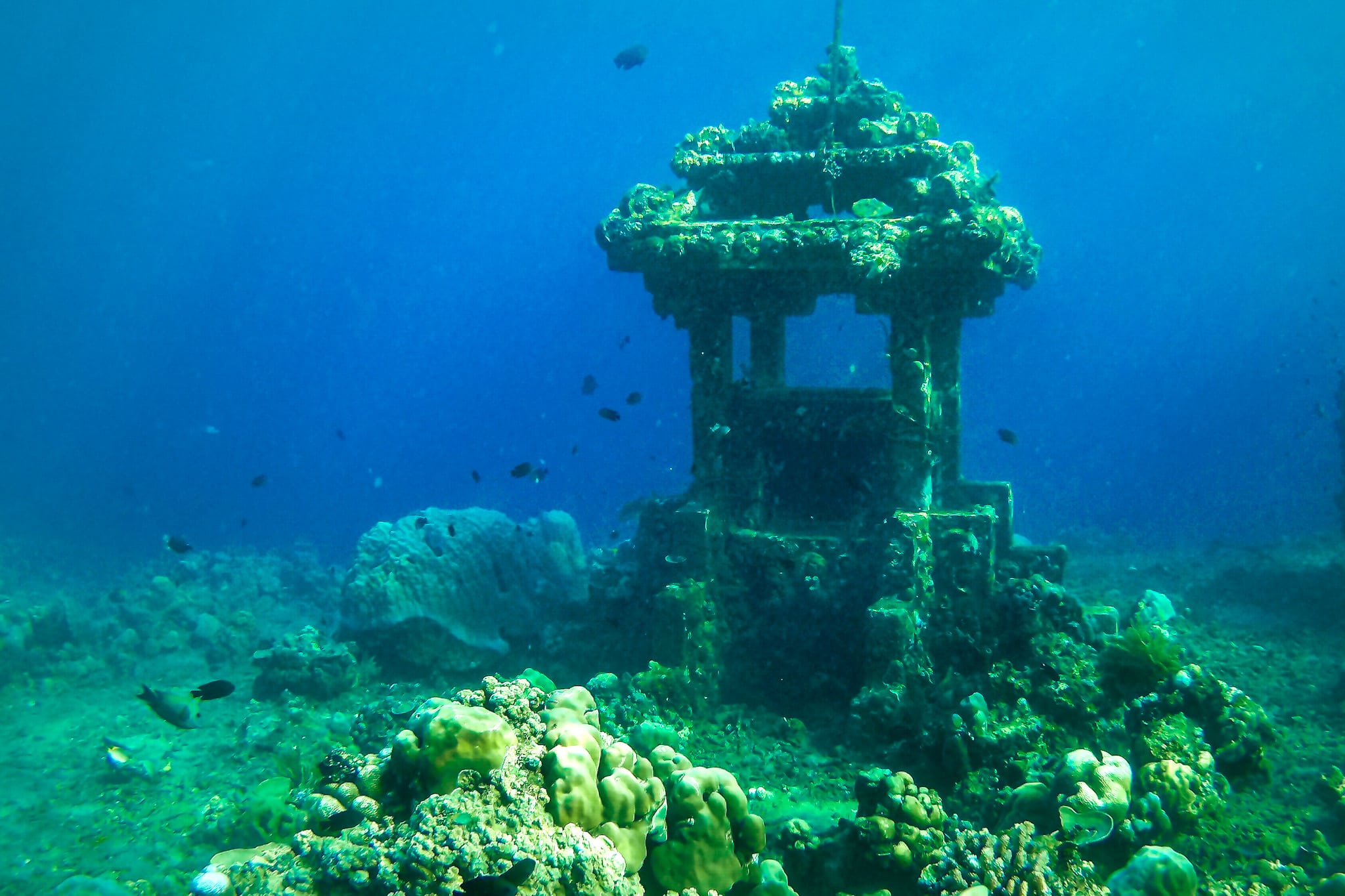
Amed is a tranquil coastal village nestled on the northeastern coast of Bali, renowned for its pristine coral reefs, vibrant marine life, and laid-back atmosphere. This hidden gem is a haven for diving and snorkeling enthusiasts, offering some of the island’s best underwater adventures.
How to Get There from the Capital (Jakarta):
- By Air: Fly from Jakarta to Ngurah Rai International Airport in Denpasar, Bali. From there, take a taxi or shuttle bus to Amed, approximately 2.5 to 3 hours away.
- By Road: Travel by bus or private car from Jakarta to Denpasar. From Denpasar, continue by taxi or public bus to Amed.
- By Sea: While there are no direct sea routes to Amed, travelers can opt for a combination of sea and road travel via ferry from Java to Bali, followed by a taxi or hired vehicle to Amed.
Other Transportation:
- Private: Hire a private car or taxi for convenience and flexibility, with rates varying based on distance and time of travel.
- Motorbike Rental: Renting a scooter or motorbike is a popular option for exploring the coastal areas of eastern Bali, including Amed, offering freedom and affordability for budget travelers.
Transportation Cost:
- Public: Public buses or shuttle services from Denpasar to Amed typically cost around IDR 100,000 to IDR 150,000 ($7 to $10 USD) per person. Additional transportation may be needed from the drop-off point to accommodations or dive sites.
- Private: Taxi fares from Ngurah Rai International Airport to Amed range from IDR 700,000 to IDR 1,000,000 ($50 to $70 USD), depending on distance and vehicle type.
Must to Activities:
- Dive or snorkel along Amed’s colorful coral reefs, teeming with tropical fish, sea turtles, and other marine creatures.
- Explore nearby dive sites such as the USS Liberty Shipwreck in Tulamben or the Japanese Wreck in Banyuning, offering diverse underwater ecosystems and fascinating underwater scenery.
- Take a traditional jukung boat tour along the coast of Amed, visiting hidden coves, secluded beaches, and picturesque fishing villages.
- Relax on the black sand beaches of Amed, soaking up the sun and enjoying the laid-back ambiance of this coastal paradise.
- Discover local culture and traditions by visiting nearby temples, markets, and villages, immersing yourself in the authentic charm of rural Bali.
Entrance Fee:
- Entrance fees to dive sites or snorkeling spots may apply, typically ranging from IDR 50,000 to IDR 200,000 ($3.50 to $14 USD) per person. Prices may vary depending on the operator and facilities available.
Transport: How to get to Bali?
Transportation in Bali: A Guide for Budget Backpackers and Travelers
Bali, known as the Island of the Gods, is a paradise destination for travelers seeking natural beauty, vibrant culture, and adventure. Navigating transportation in Bali, however, can be daunting, especially for budget-conscious backpackers. In this guide, we’ll explore the various modes of transportation available, how to get to Bali from the capital, transportation costs, quality of travel, and potential difficulties to be aware of.
Getting to Bali from the Capital:
The capital of Indonesia, Jakarta, serves as the primary gateway to Bali. Travelers have several options for reaching Bali from Jakarta:
- By Air: The most convenient and quickest way to reach Bali from Jakarta is by air. Numerous airlines operate daily flights from Soekarno-Hatta International Airport in Jakarta to Ngurah Rai International Airport in Denpasar, Bali. Flight duration is approximately 1.5 to 2 hours. Budget airlines often offer affordable fares for those booking in advance.
- By Sea: For a more adventurous journey, travelers can take a ferry from the port of Merak in Java to Gilimanuk in West Bali. From Gilimanuk, buses or hired vehicles can transport travelers to popular destinations in Bali. However, this option is time-consuming and may not be the most convenient for budget travelers.
- By Road: Travelers can also opt for a combination of road and sea travel by taking a bus from Jakarta to Banyuwangi in East Java, followed by a ferry crossing to Gilimanuk in Bali. This option offers a scenic journey through Java but requires multiple transfers and may not be ideal for budget travelers with limited time.
Modes of Transportation in Bali:
- Bemo (Minivan): Bemos are small minivans that serve as the primary mode of public transportation in Bali. They operate fixed routes and are a budget-friendly option for short distances. However, they can be crowded, uncomfortable, and may not adhere to strict schedules.
- Motorbike Rental: Renting a motorbike or scooter is a popular choice for budget travelers in Bali. It offers flexibility, allowing travelers to explore the island at their own pace. Rental costs vary but are generally affordable, starting from around IDR 50,000 to IDR 100,000 ($3.50 to $7 USD) per day.
- Ojek (Motorcycle Taxi): Ojeks are motorcycle taxis commonly found in urban areas. They are convenient for short-distance travel and navigating through traffic jams. Prices are negotiable but generally inexpensive, making them a budget-friendly option for solo travelers.
- Public Bus: Bali has a limited public bus system that connects major towns and tourist areas. While buses are inexpensive, they can be infrequent and unreliable. They may not be the most comfortable option for travelers with large bags or those exploring remote areas.
- Online Ride-Hailing Services: Apps like Gojek and Grab offer ride-hailing services in Bali, providing convenient and affordable transportation options. Travelers can book cars or motorcycles for short or long distances, with transparent pricing and the option to pay electronically.
Transportation Costs:
- Bemo: Bemo fares vary depending on the distance traveled but are generally inexpensive, ranging from IDR 5,000 to IDR 20,000 ($0.35 to $1.50 USD) per ride.
- Motorbike Rental: Rental costs for motorbikes or scooters start from around IDR 50,000 to IDR 100,000 ($3.50 to $7 USD) per day, excluding fuel costs.
- Ojek: Ojek fares are negotiable but typically range from IDR 10,000 to IDR 50,000 ($0.70 to $3.50 USD) for short distances.
- Public Bus: Public bus fares are low, usually starting from IDR 5,000 to IDR 20,000 ($0.35 to $1.50 USD) per ride, depending on the route.
- Online Ride-Hailing Services: Prices for ride-hailing services vary based on distance, time of day, and demand. Generally, they are affordable and competitive with other transportation options.
Quality of Travel:
- Bemo: While bemos are cheap, they may not offer the most comfortable or reliable travel experience. They can be overcrowded, hot, and prone to frequent stops.
- Motorbike Rental: Renting a motorbike provides freedom and flexibility but comes with risks, especially for inexperienced riders. Road conditions and traffic can be challenging, and accidents are not uncommon.
- Ojek: Ojeks are convenient for short trips and navigating through traffic, but safety standards may vary. Helmets should be provided, and travelers should negotiate fares in advance.
- Public Bus: Bali’s public buses are basic and may not be well-maintained. They are suitable for budget travelers seeking the cheapest option but may not offer comfort or reliability.
- Online Ride-Hailing Services: Ride-hailing services like Gojek and Grab offer reliable and convenient transportation options with upfront pricing and the ability to track rides in real-time.
Difficulties Using Bali Transportation System:
- Language Barrier: Communication with drivers or navigating bus routes may be challenging for travelers who do not speak Indonesian.
- Traffic Congestion: Bali’s roads can be congested, especially in popular tourist areas like Kuta and Seminyak, leading to delays and longer travel times.
- Safety Concerns: Road safety standards may not be as strict as in other countries, and traffic accidents are a risk, particularly for inexperienced motorbike riders.
- Limited Coverage: Public transportation options may be limited, especially in remote or less touristy areas of Bali, making it difficult to reach certain destinations without a private vehicle.
In conclusion, while navigating transportation in Bali can present challenges for budget backpackers and travelers, there are plenty of affordable options available. From bemos and motorbike rentals to online ride-hailing services, travelers can choose the mode of transport that best suits their budget, comfort level, and itinerary. By planning ahead, staying informed, and exercising caution, travelers can explore the beauty of Bali without breaking the bank.
Insights to be Overviewed:
Bali Travel Guide for Budget Travelers
Visa Process and Restrictions:
- Visa requirements for Bali vary depending on your nationality. Many countries, including the United States and most Schengen countries, receive a free visa exemption upon arrival, allowing stays of up to 30 days.
- Ensure your passport has at least six months validity from your planned date of departure.
- Extensions are possible for an additional fee if you wish to stay longer. Check the Indonesian embassy or consulate in your country for specific visa requirements.
Things We Shouldn’t Do When We Go There:
- Do not disrespect local customs, traditions, or religious sites. Dress modestly when visiting temples and remove shoes before entering.
- Avoid engaging in illegal activities, such as drug use or trafficking. Indonesian laws are strict and penalties severe.
- Refrain from excessive bargaining in markets or with street vendors. While haggling is common, be respectful and fair in your negotiations.
Currency and Money-Saving Tips:
- The official currency of Indonesia is the Indonesian Rupiah (IDR). Carry small denominations for convenience, as larger bills may not be accepted in small shops or taxis.
- Avoid currency exchange services at airports or tourist areas, as they often offer unfavorable rates. Use ATMs to withdraw cash instead, but be cautious of transaction fees.
- Bargain when shopping in markets or negotiating prices for services, but do so respectfully and with a smile. Polite bargaining is part of the culture and can result in significant savings.
Budget Accommodations and Locations:
- Consider staying in guesthouses, hostels, or homestays to save on accommodation costs. Areas like Kuta, Seminyak, and Ubud offer a range of budget-friendly options.
- Look for accommodations with shared facilities, such as bathrooms and kitchens, to further reduce costs.
- Booking in advance online or through travel apps can often secure better deals than walking in.
Local SIM Provider and Best Plans:
- Telkomsel, Indosat Ooredoo, and XL Axiata are popular SIM card providers in Bali. Purchase a prepaid SIM card at airports, convenience stores, or official outlets.
- Look for tourist-specific packages offering data, calls, and SMS. Plans typically range from daily to monthly options, with prices starting from around IDR 50,000 ($3.50 USD).
Basic Words in Local Language:
- “Terima kasih” – Thank you
- “Selamat pagi” – Good morning
- “Tolong” – Please
- “Permisi” – Excuse me
- “Apa kabar?” – How are you?
- “Sama-sama” – You’re welcome
Local Cuisine and Must-Try Foods:
- Nasi Goreng: Indonesian fried rice with vegetables, egg, and choice of meat. Cost: IDR 20,000 – 50,000 ($1.50 – $3.50 USD).
- Mie Goreng: Fried noodles with vegetables, egg, and spices. Cost: IDR 20,000 – 50,000 ($1.50 – $3.50 USD).
- Satay: Grilled skewers of meat, typically served with peanut sauce. Cost: IDR 10,000 – 30,000 ($0.70 – $2 USD) per skewer.
- Babi Guling: Balinese roast pig, a specialty dish often served during ceremonies or celebrations. Cost: IDR 50,000 – 100,000 ($3.50 – $7 USD) per serving.
- Warung (local eateries) offer affordable meals, while street food stalls provide inexpensive snacks and treats.
Wanderer’s Word
For budget travelers, Bali is not just a destination but a gateway to a world of affordability and adventure. By understanding visa requirements, embracing cultural sensitivity, and leveraging money-saving strategies, we unlock the full potential of our journey without compromising on experiences. From sampling mouthwatering local delicacies to finding hidden gems for accommodations and navigating the island’s transportation network economically, every decision adds to the richness of our Bali experience. As we bid farewell to this enchanting island, we depart with hearts full of memories, pockets intact, and a newfound appreciation for the endless possibilities of budget travel in Bali.
"Travel is the only thing you buy that makes you richer."

